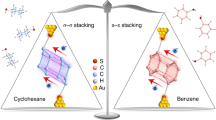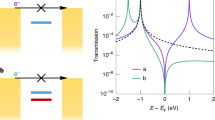Abstract
Recent observations of destructive quantum interference in single-molecule junctions confirm the role of quantum effects in the electronic conductance properties of molecular systems. These effects are central to a broad range of chemical and biological processes and may be beneficial for the design of single-molecule electronic components to exploit the intrinsic quantum effects that occur at the molecular scale. Here we show that destructive interference can be turned on or off within the same molecular system by mechanically controlling its conformation. Using a combination of ab initio calculations and single-molecule conductance measurements, we demonstrate the existence of a quasiperiodic destructive quantum-interference pattern along the breaking traces of π-stacked molecular dimers. The results demonstrate that it is possible to control the molecular conductance over more than one order of magnitude and with a sub-ångström resolution by exploiting the subtle structure–property relationship of π-stacked dimers.
This is a preview of subscription content, access via your institution
Access options
Subscribe to this journal
Receive 12 print issues and online access
$259.00 per year
only $21.58 per issue
Buy this article
- Purchase on Springer Link
- Instant access to full article PDF
Prices may be subject to local taxes which are calculated during checkout




Similar content being viewed by others
References
Núñez, M. E., Hall, D. B. & Barton, J. K. Long-range oxidative damage to DNA: effects of distance and sequence. Chem. Biol. 6, 85–97 (1999).
Merino, E. J., Boal, A. K. & Barton, J. K. Biological contexts for DNA charge transport chemistry. Curr. Opin. Chem. Biol. 12, 229–237 (2008).
Brettel, K. & Leibl, W. Electron transfer in photosystem I. Biochim. Biophys. Acta 1507, 100–114 (2001).
Wasielewski, M. R. Photoinduced electron transfer in supramolecular systems for artificial photosynthesis. Chem. Rev. 92, 435–461 (1992).
Coropceanu, V. et al. Charge transport in organic semiconductors. Chem. Rev. 107, 926–952 (2007).
Sirringhaus, H. et al. Two-dimensional charge transport in self-organized, high-mobility conjugated polymers. Nature 401, 685–688 (1999).
Yi, Y., Coropceanu, V. & Bredas, J.-L. A comparative theoretical study of exciton-dissociation and charge-recombination processes in oligothiophene/fullerene and oligothiophene/perylenediimide complexes for organic solar cells. J. Mater. Chem. 21, 1479–1486 (2011).
Solomon, G. C., Herrmann, C., Vura-Weis, J., Wasielewski, M. R. & Ratner, M. A. The chameleonic nature of electron transport through π-stacked systems. J. Am. Chem. Soc. 132, 7887–7889 (2010).
Delgado, M. C. R., Kim, E.-G., da Silva Filho, D. A. & Bredas, J.-L. Tuning the charge-transport parameters of perylene diimide single crystals via end and/or core functionalization: a density functional theory investigation. J. Am. Chem. Soc. 132, 3375–3387 (2010).
Wu, S. et al. Molecular junctions based on aromatic coupling. Nature Nanotech. 3, 569–574 (2008).
González, M. T. et al. Break-junction experiments on acetyl-protected conjugated dithiols under different environmental conditions. J. Phys. Chem. C 115, 17973–17978 (2011).
Fujii, S. et al. Rectifying electron-transport properties through stacks of aromatic molecules inserted into a self-assembled cage. J. Am. Chem. Soc. 137, 5939–5947 (2015).
Martín, S. et al. Identifying diversity in nanoscale electrical break junctions. J. Am. Chem. Soc. 132, 9157–9164 (2010).
Batra, A. et al. Quantifying through-space charge transfer dynamics in π-coupled molecular systems. Nature Commun. 3, 1086 (2012).
Tao, N. J. Electron transport in molecular junctions. Nature Nanotech. 1, 173–181 (2006).
Li, Q. & Solomon, G. C. Exploring coherent transport through π-stacked systems for molecular electronic devices. Faraday Discuss. 174, 21–35 (2014).
Li-Li, L., Xiu-Neng, S., Yi, L. & Chuan-Kui, W. Formation and electronic transport properties of bimolecular junctions based on aromatic coupling. J. Phys Condens. Matter 22, 325102 (2010).
Solomon, G. C. et al. Quantum interference in acyclic systems: conductance of cross-conjugated molecules. J. Am. Chem. Soc. 130, 17301–17308 (2008).
Guedon, C. M. et al. Observation of quantum interference in molecular charge transport. Nature Nanotech. 7, 305–309 (2012).
Sautet, P. & Joachim, C. Electronic interference produced by a benzene embedded in a polyacetylene chain. Chem. Phys. Lett. 153, 511–516 (1988).
Stafford, C. A., Cardamone, D. M. & Mazumdar, S. The quantum interference effect transistor. Nanotechnology 18, 42014 (2007).
Baer, R. & Neuhauser, D. Phase coherent electronics: a molecular switch based on quantum interference. J. Am. Chem. Soc. 124, 4200–4201 (2002).
Perrin, M. et al. Large negative differential conductance in single-molecule break junctions. Nature Nanotech. 9, 830–834 (2014).
Frisenda, R. et al. Electrical properties and mechanical stability of anchoring groups for single-molecule electronics. Beilstein J. Nanotechnol. 6, 1558–1567 (2015).
Cuevas, J. C. & Scheer, E. Molecular Electronics: An Introduction to Theory and Experiment (World Scientific, 2010).
Verzijl, C. J. O., Seldenthuis, J. S. & Thijssen, J. M. Applicability of the wide-band limit in DFT-based molecular transport calculations. J. Chem. Phys. 138, 094102 (2013).
He, J. et al. Measuring single molecule conductance with break junctions. Faraday Discuss. 131, 145–154 (2006).
Frisenda, R., Perrin, M. L., Valkenier, H., Hummelen, J. C. & van der Zant, H. S. J. Statistical analysis of single-molecule breaking traces. Phys. Status Solidi B 250, 2431–2436 (2013).
Brychta, R. J., Shiavi, R., Robertson, D. & Diedrich, A. Spike detection in human muscle sympathetic nerve activity using the kurtosis of stationary wavelet transform coefficients. J. Neurosci. Methods 160, 359–367 (2007).
te Velde, G. et al. Chemistry with ADF. J. Comp. Chem. 22, 931–967 (2001).
Senthilkumar, K., Grozema, F. C., Bickelhaupt, F. M. & Siebbeles, L. D. A. Charge transport in columnar stacked triphenylenes: effects of conformational fluctuations on charge transfer integrals and site energies. J. Chem. Phys. 119, 9809 (2003).
Martin, C. A., Smit, R. H. M., van Egmond, R., van der Zant, H. S. J. & van Ruitenbeek, J. M. A versatile low-temperature setup for the electrical characterization of single-molecule junctions. Rev. Sci. Instrum. 82, 053907 (2011).
Kleinberg, J. in Proc. 8th ACM SIGKDD Int. Conf. Knowledge Discovery and Data Mining 91–101 (ACM, 2002).
Acknowledgements
The research leading to these results has received funding from the European Research Council (ERC) FP7 ERC Grant Agreement No. 240299 (Mols@Mols) and Horizon 2020 ERC Grant Agreement No. 648433.
Author information
Authors and Affiliations
Contributions
N.R. and F.C.G. performed the electronic transport calculations and the molecular dynamics simulations. R.F., V.A.E.C.J. and H.S.J.Z. performed the break-junction experiments. R.F. designed and implemented the analysis of the plateaus. N.R. designed and implemented the higher-order statistical analysis of conductance drops. All the authors wrote the manuscript.
Corresponding authors
Ethics declarations
Competing interests
The authors declare no competing financial interests.
Supplementary information
Supplementary information
Supplementary information (PDF 14468 kb)
Rights and permissions
About this article
Cite this article
Frisenda, R., Janssen, V., Grozema, F. et al. Mechanically controlled quantum interference in individual π-stacked dimers. Nature Chem 8, 1099–1104 (2016). https://doi.org/10.1038/nchem.2588
Received:
Accepted:
Published:
Issue Date:
DOI: https://doi.org/10.1038/nchem.2588
This article is cited by
-
Controlling piezoresistance in single molecules through the isomerisation of bullvalenes
Nature Communications (2023)
-
High performance mechano-optoelectronic molecular switch
Nature Communications (2023)
-
In-situ electro-responsive through-space coupling enabling foldamers as volatile memory elements
Nature Communications (2023)
-
Molecule-based vertical transistor via intermolecular charge transport through π-π stacking
Nano Research (2023)
-
σ–σ Stacked supramolecular junctions
Nature Chemistry (2022)



